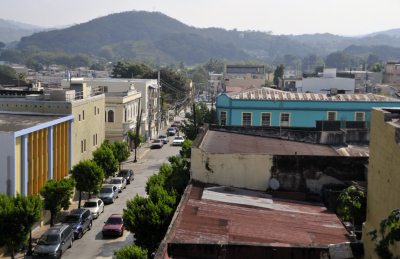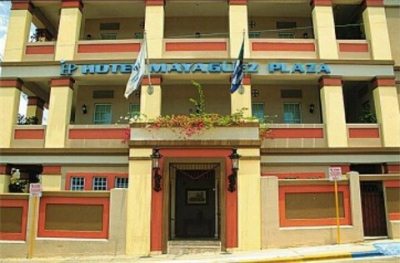|
Mayaguez
Rincon is the Riviera of all
of Puerto Rico. The 100 places book said we should stay there in The Horned
Dorset. I checked their website and the only room available was $1248, so we
plumped to go more interesting than the beach and stay in downtown Mayaguez. The
town is the eighth-largest
municipality of Puerto Rico. Also known as The Sultaness of the West,
City of Pure Waters, City of the Mango or City of God, on
the 6th of April 1894 the Spanish crown gave it the formal title of
"Excelente ciudad de Mayaguez" Mayaguez is located in the center of the
western coast on the island.
 
 
Our hotel was
a small chain on the island called Howard Johnson.
The pool with its feature waterfalls made us giggle. "swim at your own risk " -
in three foot six???
 
Next morning
we had to go to the Bakery, a wonderful town hub of activity opposite for a ham
and cheese toasty, coffee and juice. We paid a dollar extra for cappuccino when
we saw spoons standing in the centre of everyone else's coffee
cups.
History:
Mayaguez
was officially founded on the 18th of September 1760 by a group led
by Faustino Martinez de Matos, Juan de Silva and Juan de Aponte, at a hill
located about one kilometre inland from Mayaguez Bay and the outlet of the
Yaguez River. The Spanish Crown granted the founders the right to
self-government in 1763, formally separating the town from the larger San
German. Originally the settlement was named Nuestra Senora de la Candelaria
de Mayaguez (Our Lady of Candelaria of Mayagüez) as to evoke an apparition
of the Virgin Mary on the island of Tenerife. Most of the town's settlers,
including its founders, originally migrated from the archipielago, whose patron
saint is the Virgin of Candelaria.
 
Bear liked the town, I loved the
architecture
On the 7th of May 1836, the
settlement was elevated to the royal status of villa, and Rafael Mangual was
named its first mayor. At the time, the villa's principal economic activity was
agriculture. The famous patriot, educator, sociologist, philosopher, essayist
and novelist Eugenio Maria de Hostos was born in Mayaguez in 1839.
On the
10th of July 1877 the villa formally received its city charter from
the Royal Crown of Spain.
The Catholic Church. When the 06:00 bells tolled to call
the faithful, the shape of our hotel echoed as if the bells were in our
bathroom
The city's main Roman Catholic church,
Our Lady of the Candelaria -
plot consecrated on the 21st of August 1760, first masonry building
erected in 1780, current church originally built in 1836 and was rebuilt in
1922. The original redesign by architect Luis Perocier sought to restore the
building to its original splendor. Not only had the 1918 earthquake destroyed
the temple's ceiling, but a lightning bolt also struck and tore down a
wedge-shaped corner of one of its two bell towers. However, lack of proper
funding and the extent of the damage of the original structure forced the actual
rebuilding of the church to be scaled-down considerably. In 1911, the College of Agriculture and
Mechanical Arts was founded in Mayaguez. Today it is known as the University of
Puerto Rico at Mayaguez (UPRM) - the Caribbean's leading science and engineering
institution. Between 1962 and 1998 Mayaguez was a major tuna canning and
processing centre. At one time, 80% of all tuna products consumed in the United
States were packed in Mayaguez (the biggest employer, StarKist, had 11,000
employees working three daily shifts in the local plant's heyday). Mayaguez was
also a major textile industry hub; until very recently, almost a quarter of all
drill uniforms used by the US Army were sewn in the
city.
Geography:
Mayaguez is located near the
geographical centre of the west coast of Puerto Rico about two hours by car from
San Juan. Its land area is about seventy eight square miles. The city's terrain
includes; coast plains, river valleys, marshland, hills and mountains. Of its
multiple rivers and streams, the two most important are the Rio
Yaguez, which flows
from the Central Mountain Range through downtown until it empties into the Mona Passage (this
passage is the reason we did a road trip, the currents here are awesome and it
channels many storms); and the Rio Guanajibo, which flows through several
neighborhoods in the southern portion of the municipality until it empties in
the Mona Passage as well.
ALL IN ALL AN
INTERESTING TOWN - NOW OFF TO THE ZOO
THIS TOWN HAD A GOOD FEEL AND REALLY
QUAINT
|












